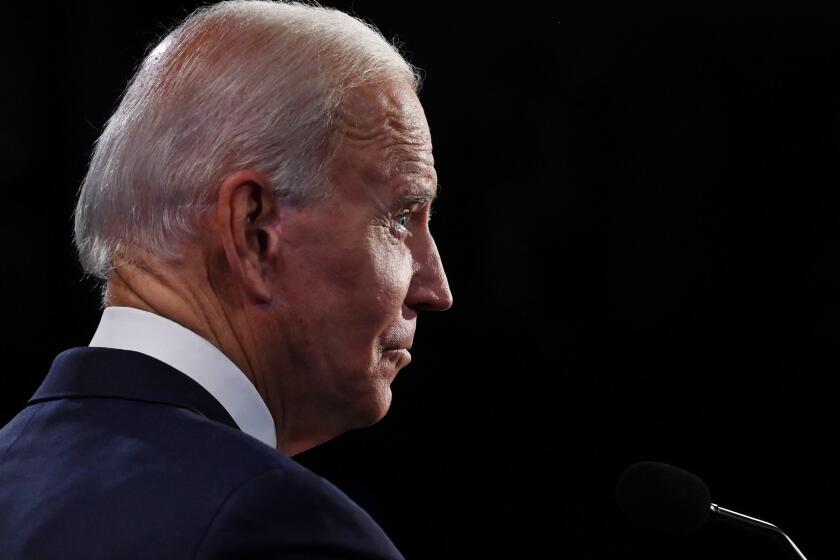State Paid 1,033 Workers Over $100,000 Last Year : Government: Some put in extra shifts or got onetime payments, list shows. Average salary is $42,000 a year.
A total of 1,033 state employees earned more than $100,000 in salary and cash benefits last year, including 244 who had incomes higher than the state’s top boss, Gov. Pete Wilson.
A 1994 payroll list prepared by the state controller’s office shows that the highest-paid employee was a 78-year-old retired USC psychiatry professor who holds down two state jobs.
An unrepentant workaholic by his own description, Dr. Irving A. Matzner was paid $196,356 in 1994 by the Department of Developmental Services for his work at Camarillo Developmental Center and by the Department of Corrections, where he treats parolees at outpatient clinics.
In a recent interview, psychiatrist Matzner analyzed his own, unflagging devotion to work. “I’m a hypomanic personality. . . . I have too much energy. I’m married too much to my profession.”
The top-pay summary--compiled from the payroll records of 250,000-plus state employees who are paid by the state controller--lists the gross earnings of individuals as reported to the Internal Revenue Service. The list does not include workers paid separately by the independent University of California.
An examination of the list, obtained by The Times under the Public Records Act, shows:
* Many government workers were able to vastly improve on their base salaries through overtime, cash bonuses and lump sum vacation payments.
* Although people might assume that the state’s top salary would go to Wilson, who makes $114,286 a year, the top salary on the list last year went to Barry A. Munitz, the Cal State University chancellor, who was paid $174,996.
* Workers eligible for overtime can sometimes make considerably more than their bosses.
* Two state employees who saved the state millions of dollars with suggestions each got more than $100,000 in bonuses for their ideas.
Yet earning $100,000 is still the great exception in government service. Most state workers fall far below that mark, earning an average of $42,000, according to the governor’s budget figures. And the average salary grew just 7.1% during Wilson’s first four years in office.
The number of employees with base salaries at or above $100,000 has probably risen very little over the past four years, said David J. Tirapelle, director of the Department of Personnel Administration. He acknowledged that the $100,000 figure is a psychological barrier for governmental entities and argued that local governments have been more comfortable pushing through that level than the state.
“A $100,000 salary is like reaching the 5,000 level on the Dow Jones [industrial average],” he said. “It’s a threshold.” The top salaries tend to hover around it, except in the California State University and University of California systems, which long ago broke through, he said.
(All the chancellors and presidents of the two university systems earn more than $100,000, and highly specialized doctors at UC campuses earn several hundred thousand dollars, officials say.)
Tirapelle said many department heads in state government saw their salaries drop below $100,000, beginning in 1991, when they followed the example of the governor and took a 5% cut in their statutory salaries.
But local governments in California, he said, “have long since blown through that.” As a result, he noted, top administrators in counties and cities frequently earn more than the governor of California.
Tirapelle is also concerned that state employees are able to make more than their bosses. For instance, second on the state’s top pay list is a San Quentin physician who received $190,038 last year.
“I don’t think that a doctor working at San Quentin should be earning more than the director of the Department of Corrections, who is in charge of 26 or 28 institutions, upward of 130,000 inmates and 30,000 employees,” Tirapelle said.
He said he was not surprised by the list but added that he would like to see a more rational system that gives the highest pay to those at the top of the bureaucracy.
Indeed, among those making more than their bosses were correctional sergeants who doubled their salaries with overtime pay transporting prisoners around the state. And there were college professors making more than campus presidents by teaching summer and night school on top of their regular loads.
Others making more than $100,000 were lower-paid people whose incomes were boosted by onetime cash settlements from disputes with their public agencies or by bonuses for making money-saving suggestions.
There was the Youth Authority schoolteacher who won a claim for retroactive overtime, a carpenter awarded four years back pay at Folsom State Prison, and a mental hospital’s pharmacist paid a bonus for saving the state more than $1 million a year.
Others climbed onto the list of those earning $100,000 or more only when they retired and converted accumulated vacation time to cash in a sizable lump sum payment.
As might be expected, there were also agency heads and program directors, judges and appeals court justices. And lots of doctors.
At the top of the list was Matzner, who works at the state hospital for the developmentally disabled in Camarillo, but also puts in long hours at Department of Corrections outpatient clinics for parolees in El Monte and Downtown Los Angeles. He rents an apartment for $400 a month on the grounds at Camarillo and garners additional pay by filling in for other doctors and by being on call through the night for emergencies.
Now in his second career after retiring from USC and his own practice, Matzner said he is not working for the money. “I made more money than that in private practice,” he said. “To tell the truth, I’m like Willie Mays . . . who said he’d [play baseball] for nothing, but don’t tell his bosses.”
Many psychiatrists and physicians were near the top of the list because they, like Matzner, held dual appointments or collected added pay for pulling extra duty.
“We have to have medical staff on duty around the clock,” said Douglas G. Arnold, chief deputy director for the Department of Developmental Services, which operates the Camarillo facility. The state mental hospitals, run by the Department of Mental Health, and the prisons, operated by the Department of Corrections, also require physicians on duty around the clock, seven days a week.
So it was that Dr. Tam D. Bui at San Quentin State Prison almost matched his $95,520 regular salary last year by working extra shifts as “medical officer of the day”--drawing $375 for each 15-hour overnight period at the end of the regular eight-hour day or an additional $200 for an added eight hours.
To get that extra medical officer pay, a physician must be at the prison around the clock--on call through the night should a prisoner need medical attention, Department of Corrections spokesman Tip Kindel said.
“When you’re medical officer of the day, you have essentially no life,” Kindel said.
Other department employees also have opportunities to accumulate sizable amounts of overtime. Correctional Sgts. Larry Parada and Jorge Sousa, who transport prisoners between facilities or for court appearances, each were able to more than double their $51,192 base salaries last year. Parada earned $108,001, according to the controller’s records; Sousa $107,649.
Kindel explained that moving prisoners up and down the state necessarily requires overtime. “Their days are very long,” Kindel said, and they must be paid for their waiting time as well as their time on the road.
Both men made more than their boss, department Director James H. Gomez, whose salary is $102,540, and who, like other top state executives, earns no overtime.
Like the prison system, the state Department of Mental Health is well-represented among highly paid state employees, largely because it requires psychiatrists and other physicians to be constantly available at the state hospitals. While their base salaries are high--often in excess of $100,000--they also have opportunities for second jobs or added shifts.
Five psychiatrists at state mental hospitals were among the 20 top-paid employees. All earned more than $149,000.
Dr. Hermenegildo M. Kadile, staff psychiatrist at Atascadero State Hospital, had a base pay of $98,600 last year, but was able to earn more for extra shifts and a part-time appointment for the Department of Corrections at Wasco State Prison. Total income: $167,734.
Dr. Gertrudis Agcaoili, a staff psychiatrist at Napa State Hospital, also worked at a part-time job--reviewing claims for the Department of Social Services. Total income: $162,699.
Department of Mental Health spokeswoman Nora Romero pointed out that state workers can hold second government jobs as long as there is no conflict. “A clerical worker could be working 8 to 5 at the Department of Mental Health and go to another department as a key data operator,” Romero said. “If they perform, the state is obliged to pay them.”
Others added to their salaries by being available on weekends or overnight. Dr. Thomas Cahill, now a medical program director at Atascadero, was paid a lump sum of $53,600 on top of his regular salary last year. The added money was a buyout of time he had banked over several years for extra shifts. His total income in 1994: $159,738.
Romero said that only the most severely ill mental patients remain in the state hospitals, and these are individuals who require a high level of care. The department provides financial bonuses to recruit and retain qualified doctors and then provides added pay to be sure there are physicians on call at all times.
“In the state hospitals we have to keep at that level of care seven days a week, 24 hours a day,” Romero said, “and we need to compensate people for the care they provide.”
Other state employees also have opportunities to increase their pay by putting in extra hours, including professors in the Cal State University system who can add to their base pay by taking on additional classes.
William M. Harris, a professor of education at Cal State Sacramento, more than doubled his salary of $62,784 by carrying an extraordinary class load. “My basic professor’s salary is payment for a basic teaching load, which is actually 15 units each semester,” said Harris, who says he trains “teachers how to teach challenged kids.”
He also teaches during the summer and conducts special classes over the winter break, on weekends and at night, which brought his total pay to $136,247 last year. That is about $1,500 more than the Sacramento campus’s president, Donald R. Gerth, was paid in 1994. In addition, Harris does “a small bit of consulting” for school districts and attorneys on the side--income that does not come from the state coffers and is not reported by the controller.
Harris explained that he is hooked on teaching. “My last kid just graduated from school,” he said. “There’s nobody at home. . . . I love to teach classes. It’s what I do for my fun and my hobby and everything.”
The controller’s list of top-paid employees, Harris noted, only shows the state-paid income of faculty members. “There are people who have outside businesses, and nobody has access to that data,” he said.
Other employees joined the ranks of those paid $100,000-plus only because of onetime settlements with the state.
Cheryl Benson, a carpenter, was one of several women in various building trades hired at Folsom State Prison in 1987. But the next year, after complaining about sexual harassment and a transfer to night duty, Benson was threatened with discipline for losing a set of “hot” keys, which could be used to gain access to secured areas within the prison.
She walked off the job, saying she was ill, and eventually filed a worker’s compensation claim. Four months after the incident, Benson was dismissed.
She appealed, contending that prison officials had harassed and then improperly dismissed her. It was not until late 1993 that the State Personnel Board agreed that she had been wrongfully terminated and ordered her reinstated with back pay and benefits. Her total compensation last year as reported by the controller: $176,751, including a lump sum payment of $160,448.
Benson said she received only a part of that money and that her legal and medical expenses have exceeded the settlement. Still distraught over her treatment, she officially left state service this June and in October filed a $1-million claim with the State Board of Control, charging “ongoing discrimination.”
Another state worker among the top-paid employees last year was attorney Sonny F. Lo, who worked in the Cal State University’s chancellor’s office in Long Beach. After 14 years as a legal counsel for the university system, Lo had obtained “permanent status,” and was guaranteed a job. But a new chancellor eliminated Lo’s post in a restructuring of Lo’s department.
He was given a year’s pay as a settlement, but he was able to find a new state post as an administrative law judge with another agency. As a result, Lo was paid the equivalent of two salaries in 1994, bringing his total wages to $165,941.
Youth Authority schoolteacher Fred Heron also had a onetime cash settlement that boosted his income above $100,000 in 1994. Heron was a full-time teacher at the O.H. Close school in Stockton, but he also had a part-time job with the Youth Authority as a counselor.
He held both jobs for several years, earning straight time for both even though his workweek exceeded 40 hours. Heron was one of 14 Youth Authority employees with similar dual appointments who argued that they were entitled to overtime.
The Youth Authority reviewed the claim and agreed, agency spokeswoman Sarah Andrade said. In 1994, Heron was paid $35,783 in retroactive overtime, bringing his total pay to $110,283.
“There are no longer any dual appointments,” Andrade said.
How did a pharmacist at Atascadero State Hospital earn more than $100,000? Fred Raleigh did it by making a suggestion in 1981 for the state to combine purchases of prescription drug supplies from a single vendor--adding to the state’s negotiating clout and reducing costs.
Under a state merit award program, employees are paid 10% of the actual net savings for the first year that a suggestion is implemented. Raleigh’s suggestion resulted in a one-year savings of $1,091,470 and he received $109,147 for his idea. One installment of his award--$57,482--brought his total income last year to $116,855.
An even larger prize for a suggestion was won by a Department of Motor Vehicle employee, who in 1982 proposed adding a line for sales price information on the standard ownership transfer form required whenever a car or truck or boat is sold. The simple suggestion allowed state tax officials to collect an additional $1.5 million in revenue the first year it was implemented seven years later.
The employee, M.C. Greenman, was earning just $16,128 a year in 1982 as a program technician and retired that year. Last year, the state paid Greenman $148,272 for the suggestion.
Since Greenman and Raleigh won their prizes, the state has put a $50,000 cap on the awards, said Shirley McCall, spokeswoman for the Department of Personnel Administration.
The controller’s top-pay list leaves out the Legislature’s staff as well as the University of California.
Only six employees of the Assembly and Senate received gross wages in excess of $100,000 in 1994, according to figures obtained from the Legislature’s payroll offices. Last year, three of those employees had higher wages than the governor: Rick Rollens, secretary of the Senate, who received $127,567; Cliff Berg, the Senate’s former executive officer, $122,061, and Bob Connelly, the Assembly’s chief administrator officer, $125,092.
(BEGIN TEXT OF INFOBOX / INFOGRAPHIC)
The Top 20
Here is a list of the top 20 highest-paid state government workers in 1994, compiled from payroll records of 250,000-plus state employees paid by the controller’s office. (Not included are workers employed and paid separately by the University of California system.) The list is based on gross wages and other cash benefits, including overtime and lump-sum vacation payments.
EMPLOYEE/AGENCY: Irving A. Matzner/Developmental Services
JOB: Psychiatrist
‘94 WAGES: $196,356
COMMENT: Worked at Camarillo State Hospital; had second job with Corrections.
****
EMPLOYEE/AGENCY: Tam D. Bui/Corrections
JOB: Physician
‘94 WAGES: $190,038
COMMENT: Doctor at San Quentin State Prison. Received additional $94,518 for being on call at night.
****
EMPLOYEE/AGENCY: Cheryl A. Benson/Corrections
JOB: Carpenter
‘94 WAGES: $176,751
COMMENT: Folsom Prison. Included four years back pay, settlement of wrongful dismissal, sexual harassment claims.
****
EMPLOYEE/AGENCY: Barry A. Munitz/Cal State University
JOB: Chancellor
‘94 WAGES: $174,996
COMMENT: Salary for heading California State University system (just raised to $190,008).
****
EMPLOYEE/AGENCY: Hermenegildo M. Kadile/Mental Health
JOB: Psychiatrist
‘94 WAGES: $167,734
COMMENT: Worked at Atascadero State Hospital; additional job at Wasco State Prison. Extra pay for added shifts.
****
EMPLOYEE/AGENCY: Sonny F. Lo/Cal State University
JOB: Lawyer
‘94 WAGES: $165,941
COMMENT: Paid by state for job as administrative law judge. Given one year’s severance when job in chancellor’s office eliminated. Now with Alcoholic Beverage Control.
****
EMPLOYEE/AGENCY: Gertrudis C. Agcaoili/Mental Health
JOB: Psychiatrist
‘94 WAGES: $162,699
COMMENT: Worked at Napa State Hospital. Held part-time job with Department of Social Services.
****
EMPLOYEE/AGENCY: Thomas G. Cahill/Mental Health
JOB: Psychiatrist
‘94 WAGES: $159,738
COMMENT: Worked at Atascadero State Hospital. Pay included $53,600 for accumulated extra shifts.
****
EMPLOYEE/AGENCY: Edward O. Palmer/Corrections
JOB: Physician
‘94 WAGES: $156,019
COMMENT: Worked at North Kern State Prison, accumulated $60,900 in overtime. Includes $10,690 for disability.
****
EMPLOYEE/AGENCY: Phillip L. Kelly/Mental Health
JOB: Psychiatrist
‘94 WAGES: $155,064
COMMENT: Worked at Atascadero State Hospital. Pay included $50,980 for accumulated extra shifts.
****
EMPLOYEE/AGENCY: John A. Webb/State Compensation Ins. Fund
JOB: President
‘94 WAGES: $153,723
COMMENT: Headed the state-run workers’ compensation insurance fund.
****
EMPLOYEE/AGENCY: Asha Gandhi/Mental Health
JOB: Psychiatrist
‘94 WAGES: $149,978
COMMENT: Worked at Vacaville Psychiatric Facility. Total included added pay for extra shifts, part time with Corrections.
****
EMPLOYEE/AGENCY: Janice R. Brown/Governor’s office
JOB: Legal counsel
‘94 WAGES: $149,320
COMMENT: Included $52,359 in leave-time pay she took when appointed appellate court judge.
****
EMPLOYEE/AGENCY: Lee R. Kerschner/Cal State University
JOB: President
‘94 WAGES: $148,352
COMMENT: Headed Stanislaus campus.
****
EMPLOYEE/AGENCY: M.C. Greenman/Motor Vehicles
JOB: Program technician
‘94 WAGES: $148,272
COMMENT: Retired employee. Included cash bonus for 1982 money-saving idea.
****
EMPLOYEE/AGENCY: Margaret Broad/Cal State University
JOB: Vice chancellor
‘94 WAGES: $148,254
COMMENT: Pay included $18,000 housing allowance.
****
EMPLOYEE/AGENCY: Shelly James/Corrections
JOB: Psychiatrist
‘94 WAGES: $145,900
COMMENT: eceived added pay for extra shifts.
****
EMPLOYEE/AGENCY: Stewart G. Shimoda/Developmental Services
JOB: Physician
‘94 WAGES: $142,975
COMMENT: Worked at Fairview State Hospital. Included additional pay for overnight shifts.
****
EMPLOYEE/AGENCY: Peter S. Hoff/Cal State University
JOB: Vice chancellor
‘94 WAGES: $141,892
COMMENT: Pay included $18,000 housing allowance.
****
EMPLOYEE/AGENCY: Warren J. Baker/Cal State University
JOB: President
‘94 WAGES: $138,902
COMMENT: Headed Cal Poly San Luis Obispo.
Sources: Office of State Controller (payroll data for calendar year, 1994). Additional information provided by departments.
More to Read
Get the L.A. Times Politics newsletter
Deeply reported insights into legislation, politics and policy from Sacramento, Washington and beyond. In your inbox three times per week.
You may occasionally receive promotional content from the Los Angeles Times.






